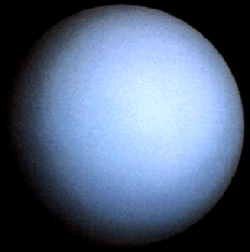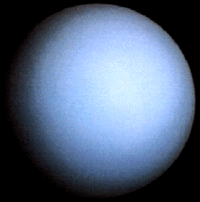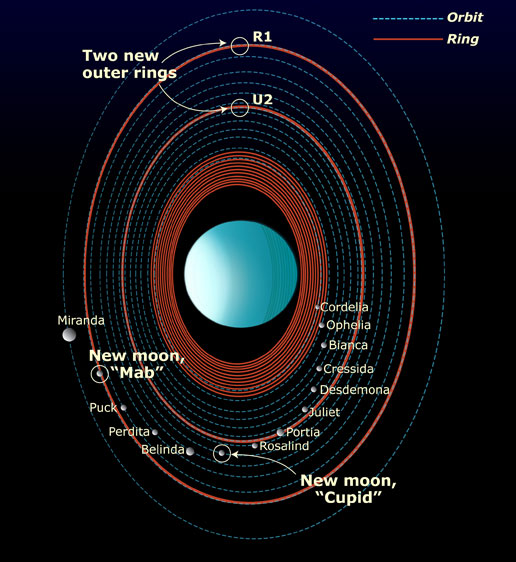Uranus (planet): Difference between revisions
Pat Palmer (talk | contribs) mNo edit summary |
mNo edit summary |
||
| Line 91: | Line 91: | ||
<references /> | <references /> | ||
</div> | </div> | ||
[[Category:Suggestion Bot Tag]] | |||
Latest revision as of 17:00, 3 November 2024
Uranus is the seventh planet, in order of distance from the Sun, in our solar system. It was the first planet, not known to the ancients, to be discovered when William Herschel cited and identified it in 1781 with the aid of a telescope.
One of the 4 planets of the outer Solar system, Uranus, like Neptune, is classified as an icy giant (Jupiter and Saturn are classified as gas giants). Most of what is known about Uranus, as well as her moons and ring system, was obtained as a result of the Voyager 2 interplanetary probe, which visited the planet in 1986.
Discovery
Prior to the invention of the telescope, the only planets known to man were the naked-eye planets, to wit, Mercury, Venus, Mars, Jupiter, and Saturn. In 1781, while engaged in a survey of the sky, William Herschel came across an object unlike the surrounding stars in that it appeared to be visibly larger, at first he suspecting it to be a comet. Upon tracking it for some time, he calculated that its orbit was nearly circular and, on that basis, concluded that it was a previously unknown planet, which was subsequently named Uranus, after the Greek god of the sky.
Following the discovery, and over the next several decades, astronomers discovered that the planetary orbit was being gravitationallly distorted, apparently by a yet more distant object. Based on these perturbations in the orbit of Uranus, the approximate location of the hypothetical planet responsible for the perturbations was computed and, in 1846, the planet Neptune was located very close to the predicted location.
Physical characteristics
Uranus's distance from the sun is about nineteen and a half times that of earth [1], has a volume 63.1 times the volume of the Earth [2] a diameter of 1.60592 x 105 km and with a mass fourteen times that of Earth (14 Earth masses or 8.6849 X 1025 kg), is the lightest of the outer planets. It has a smaller surface gravity, about 86% of Earth's.[3]
It has a much colder core than the other gas giants and radiates very little heat into space.[4]
Uranus has no solid surface. Eighty percent or more of Uranus is an extended liquid core of icy materials composed of water, ammonia and methane and higher density materials beneath.
The atmosphere is composed of mainly of hydrogen and helium and has a temperature of about -216 °C.[5] Its atmosphere has small amounts of methane, water and ammonia. Uranus gets its blue-green colour from a combination of light absorbed by the methane layer and light reflected by clouds beneath the methane. The sunlight passes through the methane, is then reflected by the clouds back through the methane layer where the red light portion of the spectrum is absorbed leaving only the blue-green spectrum to pass through, making the atmosphere appear blue-green.
Rotational characteristics
Uniquely among the planets, Neptune orbits the Sun on its side with the axis of rotation of the planet tilted just over 90 degrees with respect to the poles of the ecliptic (the plane of the planet's revolution about the Sun). Thus the rotational axis lies almost in the plane of revolution about the Sun. Due to conservation of angular momentum, the rotational axis maintains the same orientation in space as the planet revolves about the Sun. Thus, twice per planetary year, the axis is pointing almost directly towards the Sun. At the midpoints in the planet's orbit between those times, the planet is rotating in such a way that the Sun is almost on the planetary equator.
Seasons
Due to the extreme tilt of the planet's axis of rotation relative to the plane of its orbit about the Sun, the seasonal appearances on Uranus differ markedly from those on the Earth. When the planet's equator is lined up with the Sun, the Sun rises and sets once with each axial rotation of the planet (rotational period 17 hours, 14 minutes). Thus both hemispheres of the planet are exposed to solar radiation for half of each planetary day, and are in darkness for the other half, An observer on the equator would see the Sun rise, transit the sky, and then set about 8¾ hours after sunrise. A period of darkness of the same length would then ensue until the next sunrise which would occur about 8¾ hours later.
At this time, for an observer near either of the poles, the Sun would seem to circle the horizon, skimming it just above the horizon and dipping just below it once per planetary axial rotation. As the planet continued in its path about the Sun, the polar observer at one of the poles would see the Sun spiral upwards in the sky, all the while circling the sky daily, at first near the horizon, and as the Uranian year progressed, moving higher and higher until, when the pole was oriented in the direction of the Sun, it would describe a small circle high in the sky. This spiraling motion would repeat itself, though in the downward direction, as Uranus continued in its orbit.
Meanwhile, an observer at the opposite pole would experience a lenthy nighttime during which the Sun would not be visible. The days (or nights at the opposite pole) would last half the time of revolution about the Sun (approx. 42 years).
Natural satellites
Uranus has twenty-seven satellites, named after characters from Shakespeare or Pope, the largest being Titania, Oberon, Umbriel, Ariel and Miranda. Unlike some moons of the other giant planets and Earth's, none of them are larger than the dwarf planets Eris and Pluto.
- Cordelia
- Ophelia
- Bianca
- Cressida
- Desdemona
- Juliet
- Portia
- Rosalind
- Mab
- Belinda
- Perdita
- Puck
- Cupid
- Miranda
- Francisco
- Ariel
- Umbriel
- Titania
- Oberon
- Caliban
- Stephano
- Trinculo
- Sycorax
- Margaret
- Prospero
- Setebos
- Ferdinand
References
- ↑ 19.6 AU or 2,870,972,200 km
- ↑ of 6.833 X 1013 km3
- ↑ 8.43 m/s2 or 27.7 ft/s2. By comparison, an object of 100 pounds on Earth will weigh 86 on Uranus. Kilograms is in fact a measure of mass, not weight. 100 Kilgrams on Earth is still 100 kilograms on Uranus. The metric measure for weight is newtons (N). 100 kilograms on Earth where gravity is just a little less than 10 m2 weighs approximately 1000 N. The same mass on Uranus would be 860 N.
- ↑ Hawksett, David; Longstaff, Alan; Cooper, Keith; Clark, Stuart (2005). 10 Mysteries of the Solar System. Astronomy Now. Retrieved on 2006-01-16.
- ↑ -357 °F; 57 K


